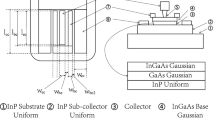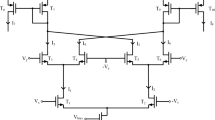Abstract
A novel accuracy-aware modeling and solving approach of adopting a back-propagation neural network (BP-NN) targeting to a classical analog five-transistor operational transconductance amplifier (OTA) is proposed in this paper. Three complex BP-NN algorithms are described amply in performance model training between multiple design factors and performance metrics, where genetic algorithm (GA), particle swarm optimization (PSO) and mind evolutionary algorithm (MEA) are introduced to further speed up the searching process for global solutions. Effectiveness comparison is performed by running simulations using SMIC 180 nm/1.8 V CMOS technology, three complex algorithms with longer time-consuming of 10 h, 30 m and 28 m demonstrate significantly superior features in solving accuracy, which show lower mean square errors (MSEs) by improvements of 82.7%, 99.7% and 99.9%, respectively. The results show that the proposed BP-NN modeling approach can be effectively aided in accelerating the global design solution of a long-cycle, nonlinear and multivariable-solved analog circuit.










Similar content being viewed by others
Data Availability
The data that support the findings of this study are available from the corresponding author upon reasonable request.
References
M. Abdel-Majeed, T. Almousa, M. Alsalman, A. Yosf, Sketic: a machine learning-based digital circuit recognition platform. Turkish J. Electr. Eng. Comput. Sci. 28(4), 2030–2045 (2020). https://doi.org/10.3906/elk-1910-16
E. Afacan, N.C. Lourenço, R.M. Martins, G. Dündar, Review: Machine learning techniques in analog/RF integrated circuit design, synthesis, layout, and test. Integr VLSI J. 77, 113–130 (2021). https://doi.org/10.1016/j.vlsi.2020.11.006
E. Afacan, M.B. Yelten, G. Dündar, Review: analog design methodologies for reliability in nanoscale CMOS circuits, in Proceedings of 14th International Conference on Synthesis, Modeling, Analysis and Simulation Methods and Applications to Circuit Design (SMACD), 2017, pp. 1–4. https://doi.org/10.1109/SMACD.2017.7981608
N.T. Almalah, F.H. Aldabbagh, Inductanceless high order low frequency filters for medical applications. Int J Electr Comput Eng 12(2), 1299–1307 (2022). https://doi.org/10.11591/ijece.v12i2.pp1299-1307
B. Bachir, A. Ali, M. Abdellah, Multiobjective optimization of an operational amplifier by the ant colony optimisation algorithm. Electr Electron Eng 2(4), 230–235 (2012). https://doi.org/10.5923/J.EEE.20120204.09
M.F. Barros, J. Guilherme, N.C. Horta, GA-SVM feasibility model and optimization kernel applied to analog IC design automation, in Proceedings of the 17th ACM Great Lakes symposium on VLSI, 2007, pp. 469–472. https://doi.org/10.1145/1228784.1228895
I. Baturone, S. Sánchez-Solano, A. Gersnoviez, M. Brox, An automated design flow from linguistic models to piecewise polynomial digital circuits, in Proceedings of the IEEE International Symposium on Circuits and Systems, 2010, pp. 3317–3320. https://doi.org/10.1109/ISCAS.2010.5537890
B. Benhala, An improved aco algorithm for the analog circuits design optimization. Int. J. Circuits Syst. Signal Process. 10, 128–133 (2016)
M. Bucolo, A. Buscarino, C. Famoso, L. Fortuna, S. Gagliano, Imperfections in integrated devices allow the emergence of unexpected strange attractors in electronic circuits. IEEE Access 9, 29573–29583 (2021). https://doi.org/10.1109/ACCESS.2021.3058506
A.F. Budak, M. Gandara, W. Shi, D.Z. Pan, N. Sun, B. Liu, An efficient analog circuit sizing method based on machine learning assisted global optimization. IEEE Trans Comput Aided Des Integr Circuits Syst. 41(5), 1209–1221 (2021). https://doi.org/10.1109/TCAD.2021.3081405
Z. Cashero, A. Chen, R. Hoppal, T. Chen, Fast evaluation of analog circuits using linear programming, in Proceedings of the IEEE Computer Society Annual Symposium on VLSI 2010, pp. 253–258. https://doi.org/10.1109/ISVLSI.2010.94
J.R. Cavanaugh, W. Bair, J.A. Movshon, Nature and interaction of signals from the receptive field center and surround in macaque V1 neurons. J. Neurophysiol. 88(5), 2530–2546 (2002). https://doi.org/10.1152/JN.00692.2001
B.P. De, R. Kar, D. Mandal, S.P. Ghoshal, Optimal selection of components value for analog active filter design using simplex particle swarm optimization. Int. J. Mach. Learn. Cybern. 6(4), 621–636 (2015). https://doi.org/10.1007/S13042-014-0299-0
M. Faseehuddin, N. Herencsar, S. Shireen, W. Tangsrirat, S.H. Md Ali, Voltage differencing buffered amplifier-based novel truly mixed-mode biquadratic universal filter with versatile input/output features. Appl. Sci. 12(3), 1229 (2022). https://doi.org/10.3390/app12031229
K. Gaj, Q. Herr, V. Adler, A. Krasniewski, E.G. Friedman, M.J. Feldman, Tools for the computer-aided design of multigigahertz superconducting digital circuits. IEEE Trans. Appl. Supercond. 9(1), 18–38 (1999). https://doi.org/10.1007/s00034-022-02219-9
S. Indrapriyadarsini, S. Mahboubi, H. Ninomiya, T. Kamio, H. Asai, A neural network approach to analog circuit design optimization using nesterov's accelerated quasi-newton method, in Proceedings of the IEEE International Symposium on Circuits and Systems (ISCAS), 2020, pp. 1–1. https://doi.org/10.1109/ISCAS45731.2020.9181152
W. Jiang, Y. Zhang, R. Wang, Comparative study on several PSO algorithms, in Proceedings of the 26th IEEE Chinese Control and Decision Conference, 2014. pp. 1117–1119. https://doi.org/10.1109/CCDC.2014.6852332
O.B. Kchaou, A. Garbaya, M. Kotti, P. Pereira, M. Fakhfakh, M.H. Fino, Sensitivity aware NSGA-II based Pareto front generation for the optimal sizing of analog circuits. Integr. VLSI J. 55, 220–226 (2016). https://doi.org/10.1016/j.vlsi.2016.07.001
M. Kumngern, F. Khateb, T. Kulej, D. Arbet, M. Akbari, Fully differential fifth-order dual-notch low-pass filter for portable EEG system. AEU Int J Electron Commun. 146, 154122 (2022). https://doi.org/10.1016/j.aeue.2022.154122
J.R. Lakowicz, Instrumentation for fluorescence spectroscopy, in Principles of Fluorescence Spectroscopy, (Springer, 1999) pp. 25–61. https://doi.org/10.1007/978-1-4615-7658-7_2
Y. Li, Y. Lin, M. Madhusudan, A.K. Sharma, W. Xu, S.S. Sapatnekar, R. Harjani, J. Hu, A customized graph neural network model for guiding analog IC placement, in Proceedings of the 2020 IEEE/ACM International Conference On Computer Aided Design (ICCAD), 2020, pp. 1–9. https://doi.org/10.1145/3400302.3415624
B. Liu, G. Chen, B. Yang, S. Nakatake, Routable and matched layout styles for analog module generation. ACM Trans. Des. Autom. Electron. Syst. 23(4), 47 (2018). https://doi.org/10.1145/3182169
M. Mahendra, S. Kumari, M. Gupta, Low voltage fully differential OTA using DTMOS based self cascode transistor with slew-rate enhancement and its filter application. Integr. VLSI J. 84, 47–61 (2022). https://doi.org/10.1016/j.vlsi.2022.01.003
S.K. Mandal, S. Sural, A. Patra, ANN-and PSO-based synthesis of on-chip spiral inductors for RF ICs. IEEE Trans. Comput. Aided Des. Integr. Circuits Syst. 27(1), 188–192 (2008). https://doi.org/10.1109/TCAD.2007.907284
H. Murata, K. Fujiyoshi, S. Nakatake, Y. Kajitani, VLSI module placement based on rectangle-packing by the sequence-pair. IEEE Trans. Comput. Aided Des. Integr. Circuits Syst. 15(12), 1518–1524 (1996). https://doi.org/10.1109/43.552084
S. Nakatake, K. Fujiyoshi, H. Murata, Y. Kajitani, Module placement on BSG-structure and IC layout applications. IEEE Trans. Comput. Aided Des. Integr. Circuits Syst. 17(6), 519–530 (1998). https://doi.org/10.1109/43.703832
W. Nye, D.C. Riley, A.L. Sangiovanni-Vincentelli, A.L. Tits, DELIGHT. SPICE: an optimization-based system for the design of integrated circuits. IEEE Trans. Comput. Aided Des. Integr. Circuits Syst. 7(4), 501–519 (1988). https://doi.org/10.1109/43.3185
J.W. Picone, Signal modeling techniques in speech recognition. Proc. IEEE 81(9), 1215–1247 (1993). https://doi.org/10.1109/5.237532
A. Pradhan, R.Vemuri, Efficient synthesis of a uniformly spread layout aware pareto surface for analog circuits, in Proceedings of the IEEE 22nd International Conference on VLSI Design, 2009, pp. 131–136. https://doi.org/10.1109/VLSI.Design.2009.67
L. Qian, Z. Bi, D. Zhou, X. Zeng, Automated technology migration methodology for mixed-signal circuit based on multistart optimization framework. IEEE Trans Very Large Scale Integr Syst. 23(11), 2595–2605 (2015). https://doi.org/10.1109/TVLSI.2014.2377013
J. Rosa, D. Guerra, N.C. Horta, R.M. Martins, N.C. Lourenço, in Using Artificial Neural Networks for Analog Integrated Circuit Design Automation, vol. 1, (Springer, 2020). https://doi.org/10.1007/978-3-030-35743-6
J. Rosa, D. Guerra, N.C. Horta, R.M. Martins, N.C. Lourenço, in Using ANNS to Size Analog Integrated Circuits, (Springer, 2020) pp. 45–66. https://doi.org/10.1007/978-3-030-35743-6_4
L.C. Severo, W. Van Noije, Single stage OTA and negative transconductance compensation. in Ultra-low Voltage Low Power Active-RC Filters and Amplifiers for Low Energy RF Receivers, (Springer, 2022) pp. 33–59. https://doi.org/10.1007/978-3-030-90103-5_3
Y. Wang, G.C. Temes, Scaling for optimum dynamic range and noise-power tradeoff: a review of analog circuit design techniques. IEEE Solid-State Circuits Mag. 11(2), 98–103 (2019). https://doi.org/10.1109/MSSC.2019.2910646
Z. Wang, X. Luo, Z. Gong, Application of deep learning in analog circuit sizing. in Proceedings of the 2018 2nd ACM International Conference on Computer Science and Artificial Intelligence, 2018. pp. 571–575. https://doi.org/10.1145/3297156.3297160
Y. Xia, A new neural network for solving linear and quadratic programming problems. IEEE Trans. Neural Netw. 7(6), 1544–1548 (1996). https://doi.org/10.1109/72.548188
B. Xu, K. Zhu, M. Liu, Y. Lin, S. Li, X. Tang, N. Sun, D.Z. Pan, MAGICAL: toward fully automated analog IC layout leveraging human and machine intelligence: invited paper, in Proceedings of the 2019 IEEE/ACM International Conference on Computer-Aided Design (ICCAD), 2019, pp. 1–8. https://doi.org/10.1109/ICCAD45719.2019.8942060
Y. Xu, K. Hsiung, X. Li, I. Nausieda, S.P. Boyd, L.T. Pileggi, OPERA: optimization with ellipsoidal uncertainty for robust analog IC design, in Proceedings of the 42nd Design Automation Conference (DAC) 2015, pp. 632–637. https://doi.org/10.1109/DAC.2005.193888
S. Zhang, W. Lyu, F. Yang, C. Yan, D. Zhou, X. Zeng, Bayesian optimization approach for analog circuit synthesis using neural network, in Proceedings of the IEEE Design, Automation & Test in Europe Conference & Exhibition (DATE), 2019, pp. 1463–1468. https://doi.org/10.23919/DATE.2019.8714788
Z. Zhao, L. Zhang, Deep reinforcement learning for analog circuit sizing, in Proceedings of the IEEE International Symposium on Circuits and Systems (ISCAS), 2020, pp. 1–5. https://doi.org/10.1109/ISCAS45731.2020.9181149
R. Zhou, P. Poechmueller, Y. Wang, An analog circuit design and optimization system with rule-guided genetic algorithm. IEEE Trans. Comput. Aided Des. Integr. Circuits Syst. 41(12), 5182–5192 (2022). https://doi.org/10.1109/TCAD.2022.3166637
Acknowledgements
This work was partially supported by the National Natural Science Foundation of China (NSFC, Grant No. 61704049), the Key Science and Technology Program of Henan Province (Grant No. 232102211066) and Graduate Quality Project of HAUST (Grant No. 2020ZYL-008).
Author information
Authors and Affiliations
Corresponding author
Ethics declarations
Conflict of interest
The authors declare that they have no known conflict of interests that could have appeared to influence the work reported in this study.
Ethical Approval
This article does not contain any studies with human participants or animals performed by any of the authors.
Informed Consent
Informed consent was obtained from all individual participants included in the study.
Consent to Participate
This manuscript is approved by all authors for publication.
Additional information
Publisher's Note
Springer Nature remains neutral with regard to jurisdictional claims in published maps and institutional affiliations.
Rights and permissions
Springer Nature or its licensor (e.g. a society or other partner) holds exclusive rights to this article under a publishing agreement with the author(s) or other rightsholder(s); author self-archiving of the accepted manuscript version of this article is solely governed by the terms of such publishing agreement and applicable law.
About this article
Cite this article
Liu, B., Zhang, W., Duan, W. et al. BP Neural Network Modeling and Solving Acceleration of Analog ICs. Circuits Syst Signal Process 42, 7023–7044 (2023). https://doi.org/10.1007/s00034-023-02443-x
Received:
Revised:
Accepted:
Published:
Issue Date:
DOI: https://doi.org/10.1007/s00034-023-02443-x




